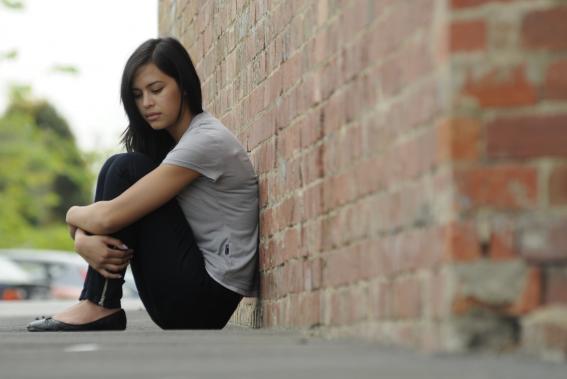What is bullying?
Bullying is not just ‘playing around’ or harmless fun. Bullying happens when someone has (or thinks they have) more power than someone else. This could be:
- power in numbers
- being older or stronger
- being popular
- being in the majority.
Bullying can increase the risk of developing mental health problems for everyone involved, particularly those experiencing the bullying.
Bullying can take place anywhere. It can happen at home, at work, in school, at TAFE/uni, online or over the phone.
Download our fact sheet on bullying
(PDF 396kb)
What are the different types of bullying?
-
verbal (e.g., putting someone down or threatening to cause harm)
-
physical (e.g., contact that hurts someone or breaks their things)
-
social (e.g., spreading rumours, excluding someone, embarrassing someone in public)
-
cyberbullying (e.g., sending harmful messages, pictures or making comments on social networking sites, like Facebook, Instagram, YouTube, TikTok or Snapchat). This type of bullying can be anonymous and posted online where it can be seen by lots of people. And it can go on 24 hours a day, 7 days a week, so people don’t get a rest from it.
Bullying can also be done secretly, like doing or saying something behind someone’s back. This type of bullying can be harder to see, but it’s no less damaging.
Bullying is not OK. It’s not simply ‘a normal part of growing up’, and help is always available to make things better.
Unfortunately bullying is common. If you’re having problems with bullying, it’s important to build your supports and know you’re not alone. Building a support network of family, friends, Elders, staff from school, TAFE, uni or work and / or mental health professionals is important to get support and put a stop to bullying as quickly as possible.
Why does bullying happen?
There are many reasons why someone might use bullying behaviour. People who bully may have experienced bullying, trauma or violence themselves. It’s still important to remember though, this doesn’t make it OK. People might use bullying because they feel peer pressure, and are trying to feel more secure, more powerful, ‘look cool’ in front of others, or feel better about themselves. This may be their way of coping if they haven’t learnt healthier ways to cope or aren’t getting the support that they need. Bullying behaviour can also happen because of jealousy, lack of knowledge, fear or misunderstanding.
It’s important to know that bullying is very complex. A person might use bullying behaviour, be a bystander while bullying is occurring, and/or experience bullying. It can depend on who is around and what the situation is. Each of these different roles can have a negative impact on mental health and can make experiencing mental health problems more likely.
What are the effects of bullying?
Anyone who has experienced bullying knows how upsetting it is. They might feel:
- alone
- unsafe
- afraid
- stressed
- humiliated
- angry
- ashamed
- rejected.
Sometimes a person might feel that there is no escape and may do things to ‘fit in’, like changing their appearance or acting differently. They may believe some of the awful things said about them, which can impact their sense of self. Sometimes they might want to hurt others, or themselves, because of it.
Being bullied can affect a person’s performance at school, uni, TAFE or work, and can continue to affect them throughout adulthood.
Experiencing bullying can also increase the risk that someone will develop depression and anxiety in the future, and it can increase the risk of self harm, suicidal thinking and suicide.
Bullying can be traumatic, especially when carried out or ignored by friends or peers, as having supportive relationships are really important in everyone’s life.
Young people report one of the worst parts of bullying is feeling like they’re going through it alone, which is why it’s so important to support anyone going through a tough time, or reaching out if you’re struggling yourself.
Being bullied can impact on many parts of our lives, but you’re not alone in this. There are things you can do and ways to get support.
What can you do about bullying?
-
Stay calm. Try focusing on your breathing as a way to stay calm. It can be really hard, but staying calm and not showing that you are overwhelmed can help you to feel better.
-
Don’t fight back. If you fight back you can make the situation worse, get hurt or be blamed for starting the trouble.
-
Try to ignore the bullying by calmly turning and walking away. If the person doing the bullying tries to stop or block you, try to be firm and clear. Having friends to stand with you or walk you away is a great idea in these moments.
-
Try to avoid the person who is bullying you or ask a friend to stay with you when they’re around.
-
Tell a trusted adult what has happened straight away. They can support you and help you to find ways to get the bullying to stop.
-
Get some more information. Schools, universities, TAFEs and workplaces have anti-bullying policies that can help you to find out what you can do.
If you're being cyberbullied, check out Understanding cyberbullying.
-
Ask them about their situation. Remember to be respectful, caring and understanding. They may not feel like answering and that is OK.
-
Listen to them and let them know they’re not alone. You don’t have to have all the answers, but it may help them to know that a lot of other young people are going through this as well.
-
Reassure them that things will get better. Remind them that they don’t have to handle this on their own.
-
Support them to seek help. Help them decide how to approach the situation. Discuss who they could talk to about the bullying, like a trusted adult. If the bullying is at school, a trusted teacher is a good place to start.
-
Make sure they’re safe. Sometimes this may mean you need to take action and speak to a trusted adult, even if they don’t want you to. Let them know what you’re planning to do if this is the case – they might not be happy about this initially but in the long run they will usually understand why you did it.
-
Look out for their mental health. Bullying can have a serious effect on someone’s mental and physical health. If you feel like your friend is struggling because of bullying, they may need professional support. They can visit a general practitioner (GP), go online to eheadspace or their local headspace centre.
Try to remember, it’s unlikely that everyone agrees with the person bullying or is going along with them, even if they don’t say something to support you. They might be afraid of getting involved or could be ignoring the person bullying as a way of not joining in. It’s important that everyone feels comfortable standing up for one another in ways that won’t put them at risk.
Who is a bystander?
Someone who sees or knows about the bullying is called a bystander. It can feel difficult to step in but a bystander can have a big effect on whether the bullying continues or not. They also have the ability to help someone who has been targeted see that they have people who support them and care for them.
What can I do if I’m a bystander?
Try not to support the bullying by looking on and doing nothing, laughing at the person being bullied or by ‘liking’ or sharing hurtful photos or posts online.
If you feel safe, step in and speak up in an assertive but not an aggressive way. Show the person that you are there for them by spending time and chatting with them and helping them to walk away from the situation. Remind the person being bullied there is always help available.
It’s important to think carefully about your safety before you try to stop the bullying. If you can’t safely take action yourself, report it to a trusted adult and let them know you want to remain anonymous.
How can I get help?
If you or someone you know is needing support with bullying, reach out to a trusted family member, friend, teacher, an Elder or a counsellor and let them know what’s going on for you. Though it can be hard reaching out to others, it can help you feel supported and less isolated.
If you ever feel unable to cope because of intense emotions of if you have thoughts of harming yourself, then ask for help immediately
For immediate help contact triple zero (000) if it is an emergency
National 24/7 crisis services:
Lifeline: 13 11 14 or lifeline.org.au
Suicide Call Back Service: 1300 659 467 or suicidecallbackservice.org.au
Beyond Blue: 1300 224 636 or beyondblue.org.au
Additional youth support services:
headspace: find your nearest centre or contact eheadspace, our phone and online service (12-25 years)
ReachOut: reachout.com.au (under 25 years)
Kids Helpline: kidshelpline.com.au or 1800 55 1800 (5-25 years)
SANE Australia: sane.org or 1800 187 263 (18+ years)
The headspace Content Reference Group oversee and approve clinical resources made available on this website.
Last reviewed 8 December 2023
Australian Institute of Health and Welfare. (2022). Australian Children, Bullying.
https://www.aihw.gov.au/reports/children-youth/australias-children/contents/justice-safety/bullying
eSafety Commissioner. (n.d). Bullying online. eSafety Commissioner.
https://www.esafety.gov.au/young-people/cyberbullying
eSafety Commissioner. (2021). The digital lives of Aussie teens. eSafety Commissioner
https://www.esafety.gov.au/about-us/research/digital-lives-aussie-teens
Gaffney, H., Ttofi, M. M., & Farrington, D. P. (2021). Effectiveness of school‐based programs to reduce bullying perpetration and victimization: An updated systematic review and meta‐analysis. Campbell Systematic Reviews, 17(2). doi:10.1002/cl2.1143
https://onlinelibrary.wiley.com/doi/full/10.1002/cl2.1143
Halliday, S., Gregory, T., Taylor, A., Digenis, C., & Turnbull, D. (2021). The Impact of Bullying Victimization in Early Adolescence on Subsequent Psychosocial and Academic Outcomes across the Adolescent Period: A Systematic Review. Journal of School Violence, 20(3), 351–373. doi:10.1080/15388220.2021.1913598
https://www.tandfonline.com/doi/abs/10.1080/15388220.2021.1913598
headspace National youth Mental Health foundation. (2020). headspace National Youth Mental Health Survey. Retrieved from https://headspace.org.au/assets/Insights-experiences-of-cyberbullying-over-time-National-Youth-Mental-Health-Survey-2020.pdf
Hellström, L., & Adrian Lundberg A. (2020) Understanding bullying from young people’s perspectives: An exploratory study, Educational Research, 62:4, 414-433, DOI: 10.1080/00131881.2020.1821388
https://www.tandfonline.com/doi/full/10.1080/00131881.2020.1821388
Irteja, I., Fakir, Md., Yunus, FM., Salam, SS., Kabir, E., and Khanam, R. (2022b). Mental Health Services Use among Adolescent Bullying Victims in Australia: Results from a Nationwide Survey. Children and Youth Services Review 132 (January 2022b): 106312. https://doi.org/10.1016/j.childyouth.2021.106312.
Mubashir, M., and Thanveera, N. (2022). Locating Cyberbullying and Mental Health in the Recent Literature. Tripodos, no. 52 (November 18, 2022): 91–107. https://doi.org/10.51698/tripodos.2022.52p91-107.
Ng, E. D., Chua, J. Y. X., & Shorey, S. (2022). The Effectiveness of Educational Interventions on Traditional Bullying and Cyberbullying Among Adolescents: A Systematic Review and Meta-Analysis. Trauma, Violence, & Abuse, 23(1), 132-151.
https://doi.org/10.1177/1524838020933867
Vrijen, C., Wiertsema, M., Ackermans, M. A., van der Ploeg, R., & Kretschmer, T. (2021). Childhood and Adolescent Bullying Perpetration and Later Substance Use: A Meta-analysis. American Academy of Pediatrics, Volume 147(3), e2020034751.
Get professional support
If you feel you need help there are a range of ways we can support you.



